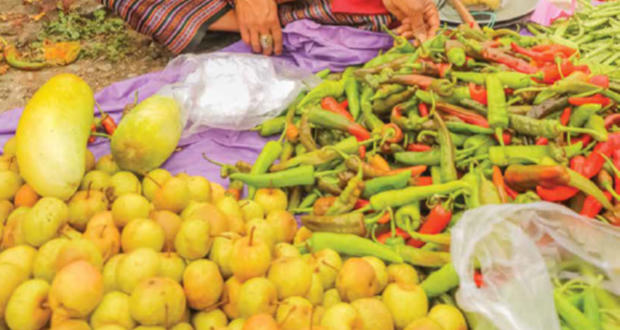In a world that talks of 'obesity epidemics' and 'global connectedness', hundreds of millions struggle each day to get enough food to survive.
For more than 800 million people on our planet, much of their daily life and what energy they have is spent in an exhausting, debilitating search for food.
A hundred million children are underweight. They are losing the battle. More than three million of them will starve to death this year.
This should be everybody’s business. It is certainly the business of universities, wherever they are and however fortunate their students might be.
In 1945, in a world determined to secure human rights and a decent life for all after the horror of two World Wars and a Great Depression, the Food and Agriculture Organization (FAO) was founded as a permanent body.
Its motto is “fiat panis” – “let there be bread” – but bread, in the sense usually understood, is not the answer, if we are to achieve the great goal of Zero Hunger.
I have been working with the United Nations FAO since 2016 as special ambassador for the International Year of the Pulses, to help meet this grandest of grand challenges. We are committed to the eradication of all hunger and all forms of malnutrition.
If there are better ways to use your mind and your energies, I can’t think of them. This is the goal that drives me, my colleagues and my students.
The Zero Hunger goal has specific targets for doubling agricultural productivity and ensuring sustainable food systems. We know that to do this, we have to improve the incomes of small-scale food producers and we have to maintain genetic diversity.
There are almost 30,000 edible plant species, but 90 per cent of the calories in the human diet comes from just over a hundred of them.
These 30,000 species include many we refer to as NUS: neglected or underutilised species. Some are wild, some are semi-domesticated, all are under-utilised.
As a rule, they do not attract the attention of commodities markets. Working with local people, we are hoping to change that. We are re-imagining some of these NUS crops as Future Smart Foods.
To make the grade, Future Smart Food crops have to be nutritionally dense, climate resilient, economically viable, and locally available and adaptable.
If we are going to feed our 800 million undernourished people, there are two significant gaps we must close.
The first is a production gap. Agricultural production will have to increase globally by at least 50 per cent to meet food demand by 2050. The second is a nutrition gap: the gap between the crops grown for commercial global market and the foods that are needed for a healthy diet.
We are looking at crops which can be grown at the local and regional level, where they contribute to environmental sustainability, as well as increasing agricultural production and improving nutritional outcomes.
Some studies have predicted that climate change in South Asia will result in declines of 14 per cent in rice production, 9-19 per cent in maize production and 44-49 per cent in wheat production.
We have to make a move on Future Smart Food crops. Traditional staple crops (such as rice, wheat and maize) are not only at threat from climate change, they don’t provide enough of the wide range of nutrients required for a healthy diet.
Together with Dr Xuan Li of the UN FAO, I have recently edited Future Smart Foods: Rediscovering hidden treasures of neglected and underutilized species for Zero Hunger in Asia, compiled by the UN FAO together with the Australian Centre for International Agriculture Research.
Scoping and prioritisation studies on these Future Smart Foods are currently being conducted in Bangladesh, Bhutan, Cambodia, Lao People’s Democratic Republic (PDR), Myanmar, Nepal, Vietnam and West Bengal.
They are working with crops we know reasonably well, like beans, lentils, peas, peanuts, pumpkin, quinoa, soybeans, sweet potatoes, taro, walnuts and yams. But there are all sorts of yams, like the purple and fancy yams of the Lao PDR, the greater yam of Vietnam, and the elephant foot yam of Myanmar and West Bengal. And there are mungo and rice beans, grass peas and cowpeas.
Then there are the crops we may never have tried, although we have heard of them: crops like buckwheat, quinoa and sorghum. We are also working with drumstick – not the icecream you buy at the supermarket – but the immature seed pods of the moringa tree (very high in vitamin C), in Bhutan, Cambodia, Myanmar, Nepal and West Bengal.
In Bangladesh we’re working with crops like foxtail millet, an ancient food source, and snake gourd – not actually made from snakes. Cambodia has ivy or scarlet gourds, cooked as a vegetable.
Myanmar is exploring the possibilities of roselle, which is also in folk medicine. Nepal has jackfruit, which can weigh as much as 55 kilos each, and the butter tree which produces ghee for cooking, fuel, manure and body lotion, as well as providing an interesting form of alcohol.
In West Bengal they are doing things with style: aromatic rice and swamp taro, as well as drumstick and jackfruit. They are also working with black and green gram (cousins of the mung bean), amaranthus (rich in Vitamins A and C, calcium and manganese), and fenugreek, used by the ancient Romans to add flavour to wine.
They all add flavour and nutrition to diets, and they are an important and growing part of the great global effort to save lives. If you put in a call, they might be coming to a restaurant near you.
 Professor Kadambot Siddique is The University of Western Australia’s Hackett Chair and Director of The UWA Institute of Agriculture. Siddique is the first Australian to be elected a fellow of the African Academy of Sciences, the only continental academy in Africa. It acts as an advisory body and a think-tank in shaping Africa’s Science, Technology and Innovation strategies and the policies that address Africa’s developmental challenges. He is also a Fellow of the Australian Academy of Technology and Engineering.
Professor Kadambot Siddique is The University of Western Australia’s Hackett Chair and Director of The UWA Institute of Agriculture. Siddique is the first Australian to be elected a fellow of the African Academy of Sciences, the only continental academy in Africa. It acts as an advisory body and a think-tank in shaping Africa’s Science, Technology and Innovation strategies and the policies that address Africa’s developmental challenges. He is also a Fellow of the Australian Academy of Technology and Engineering.
Email [email protected]
 Campus Review The latest in higher education news
Campus Review The latest in higher education news




very great sir to introduce diversity into food and crops